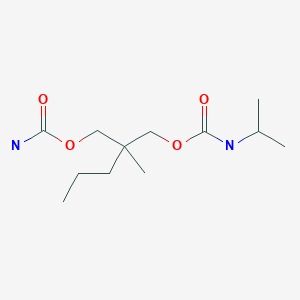Attribution Statement: LactMed is a registered trademark of the U.S. Department of Health and Human Services.
NCBI Bookshelf. A service of the National Library of Medicine, National Institutes of Health.
Drugs and Lactation Database (LactMed®) [Internet]. Bethesda (MD): National Institute of Child Health and Human Development; 2006-.
CASRN: 78-44-4

Drug Levels and Effects
Summary of Use during Lactation
If carisoprodol is required by the mother, it is not necessarily a reason to discontinue breastfeeding. Slight sedation has occurred in a breastfed newborn infant who was exposed during pregnancy and lactation; sedation might be more pronounced in newborns who are exposed for the first time during nursing. Other agents may be preferred, especially while nursing a newborn or preterm infant, or when other drugs that can cause sedation are used simultaneously.
Drug Levels
Carisoprodol is metabolized almost entirely to meprobamate which contributes to the overall sedative effect. Carisoprodol has a half-life of 4 hours and meprobamate has a half-life of about 10 hours.[1]
Maternal Levels. A mother was taking carisoprodol 700 mg three times daily during pregnancy and lactation. Maternal trough breastmilk levels of carisoprodol and meprobamate were measured before the first morning dose on 4 consecutive days at steady-state (time postpartum not stated). Average minimum breastmilk levels were 0.9 mg/L for carisoprodol and 11.6 mg/L for meprobamate. The authors calculated that the minimum infant dose of the drug plus metabolite was 1.9 mg/kg daily or 4.1% of the maternal weight-adjusted dosage. Extrapolating these results to an average (rather than minimum) dose, the authors estimated that an exclusively breastfed infant would receive 3 mg/kg daily or 6% of the maternal weight-adjusted dosage.[1]
A woman who was suspected to have been abusing carisoprodol had the drug and meprobamate detectable in breastmilk for 2 consecutive days after hospitalization; only meprobamate was detectable on day 3.[2]
A woman took carisoprodol 700 mg orally four times daily at 4- to 6-hour intervals during pregnancy and lactation for spasms of the back muscles. At 1 week postpartum, breastmilk samples were obtained 2 and 3.5 hours after doses of the drug. Two hours after a dose, carisoprodol concentration in milk was 1.4 mg/L and meprobamate was 10.9 mg/L. At 3.5 hours after the following dose, carisoprodol concentration in milk was 0.8 mg/L and meprobamate was 17.1 mg/L. The authors estimated that the maximum intake of carisoprodol plus meprobamate was 2.7 mg/kg daily or 6.9% of the maternal weight-adjusted dosage.[3]
Infant Levels. A mother took carisoprodol 700 mg orally four times daily at 4- to 6-hour intervals during pregnancy and lactation. At 1 week postpartum, her exclusively breastfed infant had unmeasurable serum concentrations of carisoprodol (<2 mg/L) and meprobamate (<4 mg/L) 2 hours after nursing (3.5 hours after the mother's previous dose). The investigators hypothesized that either the dose received by the infant was low or the infant's metabolism of the drugs may have been stimulated from the exposure during pregnancy.[3]
Effects in Breastfed Infants
A mother taking carisoprodol 700 mg plus propoxyphene 70 mg and acetaminophen 900 mg 3 times daily and partially breastfeeding her infant noticed no unusual behavior or adverse reactions in her infant. The infant grew normally and at 6 months of age, examination by a pediatrician found normal psychomotor development.[1]
A mother took carisoprodol 700 mg orally four times daily at 4- to 6-hour intervals during pregnancy and while exclusively nursing her newborn infant. Slight sedation of the infant was noted during the first month of life.[3]
Effects on Lactation and Breastmilk
Relevant published information was not found as of the revision date.
References
- 1.
- Nordeng H, Zahlsen K, Spigset O. Transfer of carisoprodol to breast milk. Ther Drug Monit. 2001;23:298-300. [PubMed: 11360042]
- 2.
- Bailey DN, Briggs JR. Carisoprodol: an unrecognized drug of abuse. Am J Clin Pathol. 2002;117:396-400. [PubMed: 11888078]
- 3.
- Briggs GG, Ambrose PJ, Nageotte MP, Padilla G. High-dose carisoprodol during pregnancy and lactation. Ann Pharmacother. 2008;42:898-901. [PubMed: 18460586]
Substance Identification
Substance Name
Carisoprodol
CAS Registry Number
78-44-4
Drug Class
- Breast Feeding
- Muscle Relaxants, Central
Disclaimer: Information presented in this database is not meant as a substitute for professional judgment. You should consult your healthcare provider for breastfeeding advice related to your particular situation. The U.S. government does not warrant or assume any liability or responsibility for the accuracy or completeness of the information on this Site.
- User and Medical Advice Disclaimer
- Drugs and Lactation Database (LactMed) - Record Format
- LactMed - Database Creation and Peer Review Process
- Fact Sheet. Drugs and Lactation Database (LactMed)
- Drugs and Lactation Database (LactMed) - Glossary
- LactMed Selected References
- Drugs and Lactation Database (LactMed) - About Dietary Supplements
- Breastfeeding Links
- PubChem SubstanceRelated PubChem Substances
- PubMedLinks to PubMed
- Review Meprobamate.[Drugs and Lactation Database (...]Review Meprobamate.. Drugs and Lactation Database (LactMed®). 2006
- Review Mebendazole.[Drugs and Lactation Database (...]Review Mebendazole.. Drugs and Lactation Database (LactMed®). 2006
- Review Carbachol.[Drugs and Lactation Database (...]Review Carbachol.. Drugs and Lactation Database (LactMed®). 2006
- Review Chloramphenicol.[Drugs and Lactation Database (...]Review Chloramphenicol.. Drugs and Lactation Database (LactMed®). 2006
- Review Felbamate.[Drugs and Lactation Database (...]Review Felbamate.. Drugs and Lactation Database (LactMed®). 2006
- Carisoprodol - Drugs and Lactation Database (LactMed®)Carisoprodol - Drugs and Lactation Database (LactMed®)
Your browsing activity is empty.
Activity recording is turned off.
See more...
